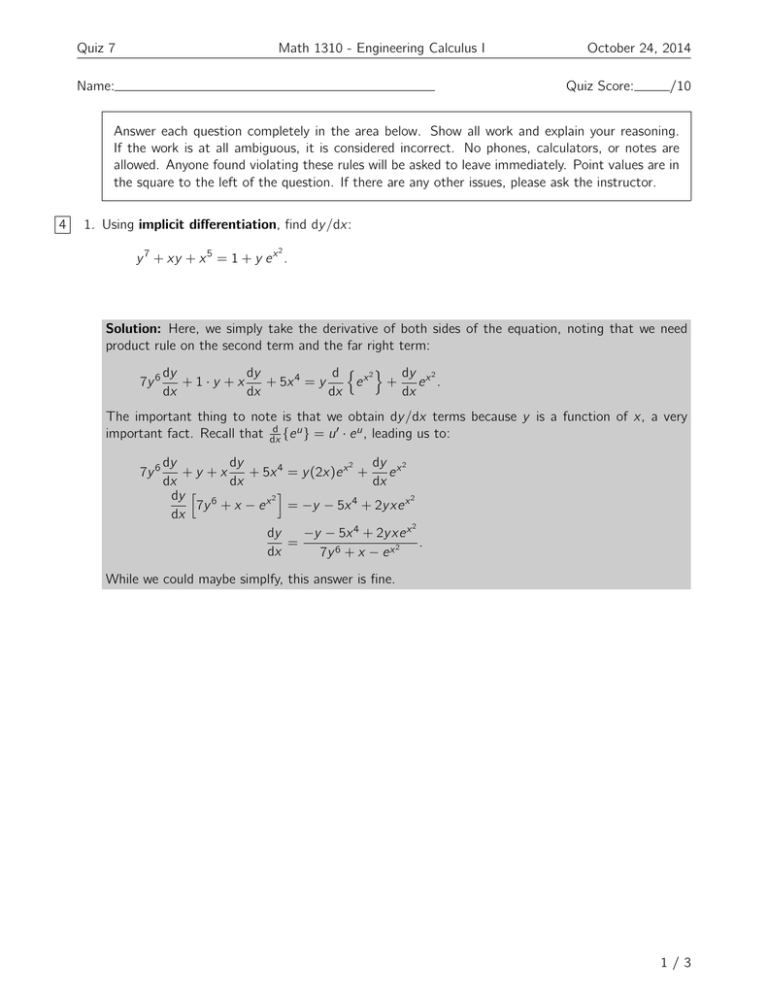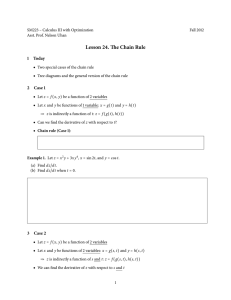Quiz 7 Math 1310 - Engineering Calculus I October 24, 2014 Name:
advertisement

Quiz 7
Math 1310 - Engineering Calculus I
Name:
October 24, 2014
Quiz Score:
/10
Answer each question completely in the area below. Show all work and explain your reasoning.
If the work is at all ambiguous, it is considered incorrect. No phones, calculators, or notes are
allowed. Anyone found violating these rules will be asked to leave immediately. Point values are in
the square to the left of the question. If there are any other issues, please ask the instructor.
4
1. Using implicit differentiation, find dy /dx:
2
y 7 + xy + x 5 = 1 + y e x .
Solution: Here, we simply take the derivative of both sides of the equation, noting that we need
product rule on the second term and the far right term:
6 dy
dy
d n x 2 o dy x 2
4
7y
+1·y +x
+ 5x = y
e
+
e .
dx
dx
dx
dx
The important thing to note is that we obtain dy /dx terms because y is a function of x, a very
d
{e u } = u 0 · e u , leading us to:
important fact. Recall that dx
7y 6
dy
dy
dy x 2
2
+y +x
+ 5x 4 = y (2x)e x +
e
dx
dx
dx
i
dy h 6
2
2
7y + x − e x = −y − 5x 4 + 2y xe x
dx
2
−y − 5x 4 + 2y xe x
dy
=
.
dx
7y 6 + x − e x 2
While we could maybe simplfy, this answer is fine.
1/3
Quiz 7
3
Math 1310 - Engineering Calculus I
October 24, 2014
2. Compute the derivative of the following function:
y = cos−1 (x 2 + 1).
Hint: try applying cos(·) to both sides if you do not remember the formula for
d
dx
cos−1 (u) .
Solution: Using the trick hinted at, we can apply cos to both sides to yield:
cos y = x 2 + 1,
which we can now perform implicit differentiation on to obtain:
− sin(y )
dy
= 2x
dx
which suggests:
dy
2x
=−
.
dx
sin y
I said in class you need not simplfy this but, on an exam, I may ask you to. What is sin y ?
sin y = sin[cos−1 (x 2 + 1)] = sin θ
We can figure out what this value is by constructing the following triangle:
1
z
θ
x2
+1
2
Notice, we’ve constructed this triangle because we want θ such that θ = cos−1 x 1+1 , that is, we
2
want the angle such that
From this right
p the ratio of the adjactent and hypotenuse is (x + 1)/1. p
2
2
2
triangle, it’s clear z = 1 − (x + 1) . We also can deduce that sin θ = z /1 = 1 − (x 2 + 1)2
since sin describes the ratio of the opposite side over the hypotenuse. Putting this all together, we
finally have:
dy
2x
= −p
.
dx
1 − (x 2 + 1)2
Notice, this equation has no y terms, making it a preferred form, as we need only know x to evaluate
the derivative.
2/3
Quiz 7
3
Math 1310 - Engineering Calculus I
October 24, 2014
3. Compute the derivative of the following function:
y = ln 1 + xe −x .
Hint: similar to the previous problem, try applying e (·) to both sides of the equation if you do not
d
remember the formula for dx
ln(u) .
Solution: Similar to the previous problem, let’s apply e to both sides of the equation to yield:
e y = 1 + xe −x .
Now, we can take derivatives by yet again recalling that
product rule on the second term:
ey
d
u
dx {e }
= u 0 · e u . Also note that we need
dy
= 1 · e −x + x(−1)e −x
dx
which suggests that:
dy
e −x − xe −x
=
.
dx
ey
Notice, we can simply more by observing that e y = 1 + xe −x , reducing our answer to:
dy
e −x − xe −x
=
,
dx
1 + xe −x
which only has x’s in it, making it a preferable answer.
3/3




